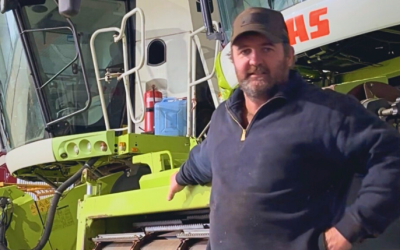
Grant Alday and daughter, Jenna
When frost devastated Grant Alday’s crops last season, he faced a choice that many farmers dread: watch potential profits wither away, or pivot fast and cut for hay. Within days, he made the call that would transform his season.
“It really took us from breaking even to making a profit,” says Grant, who farms with his wife Bron in Northwest Victoria.
“It was a somewhat difficult decision for a short period, and then it turned out to be a fantastic choice.”
Grant’s success story offers valuable insights for farmers navigating unpredictable seasons and exploring hay as a profit centre.
The Aldays typically dedicate 8-10% of their farm to oaten hay and another 8-10% to vetch, but last year’s frost changed everything. They ended up cutting lentil hay, wheaten hay, barley, oats, and vetch – producing around 9,000 bales when they’d normally make 4,000-6,000.
The decision wasn’t purely financial. “If you’ve got frosted flats, there’s still moisture in the ground, you’re going to get regrowth, particularly in barley,” Grant explains. “It was like, let’s just get rid of some of the pain, that we know is coming, at harvest time.”
The Challenges of Quick Pivots
The rapid shift to hay production created immediate logistical challenges:
- Finding extra staff (two more workers needed)
- Sourcing additional equipment (another tractor, converting a header)
- Arranging accommodation for backpackers
- Organising contractors on short notice
- Managing chemical withholding periods on previously treated crops
“We didn’t think we needed extra staff to help with our oaten hay because it was such a poor season,” Grant recalls. “Once we swung to hay, it kind of became our harvest. So straight away: find another tractor, find two more staff, find two more beds.”
Despite initial scepticism from some neighbours who thought cutting hay was “a bit stupid,” Grant stood by his decision. “We were comfortable,” Alday says. “If it doesn’t suit your personality and your system, and you don’t want to go outside what you normally do, well, I guess you stick with what you’re doing.”
The Personal Side of Hay
For Grant, hay offers something grain doesn’t – personality. “There’s a little bit more personality to hay than there is grain,” he says. “Once grain’s in a silo, it’s pretty much grain. But you pull the face off a bale of hay and go, ‘Geez, that’s got heaps better colour than I remembered.’ You know what paddock it came from, and what part of a paddock, and there’s a bit of a story behind how you put it together.”
Managing Risk: Mice, Insurance, and Storage
The decision to cut hay brings considerations beyond immediate cash flow:
Mouse control: The Aldays built approximately 50 bait stations across four hay sheds – extensive prevention that paid off with minimal rodent issues.
Insurance challenges: New regulations around distances between sheds and maximum dollar values per shed add complexity to hay storage.
Cash flow timing: Export oaten hay provides predictable income timing, similar to grain. Domestic market hay can be more uncertain, requiring financial capacity to carry inventory.
“Some of the issues around insurance now are getting really, really tough,” Grant notes.
“The challenges are around insurance and mice as much as cash flow.”
Lessons for 2025
As this season unfolds with its own challenges – late breaks and patchy germination across many districts – both farmers offer insights worth considering:
- Know your paddocks and prioritize decisions based on individual circumstances
- Consider the full picture: weeds, regrowth, harvest challenges, not just immediate income
- Be ready to pivot quickly when conditions demand it
- Have systems in place for mouse control and insurance before you need them
- Remember that hay can support grain production long-term, even if it’s not your primary focus
The 2024 season proved that flexibility and quick decision-making can turn challenges into opportunities. As Grant reflects: “It’s about profit, but it’s still a satisfying process if you do it right.”
Grant Alday was recognised as Feed Central 2025 National Award winner for his outstanding contributions to Australian hay production. His experiences demonstrate that success in hay production requires not just the right equipment and techniques, but also the willingness to make bold decisions when circumstances demand it.


